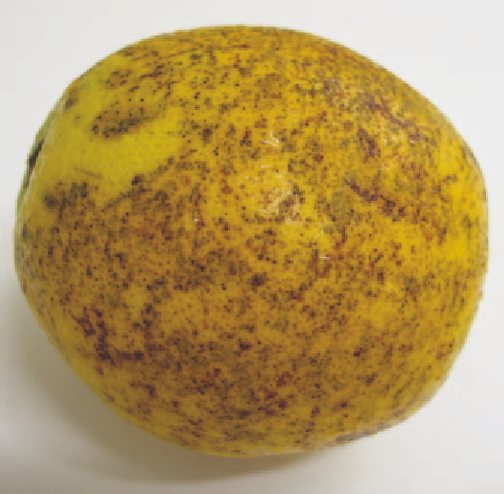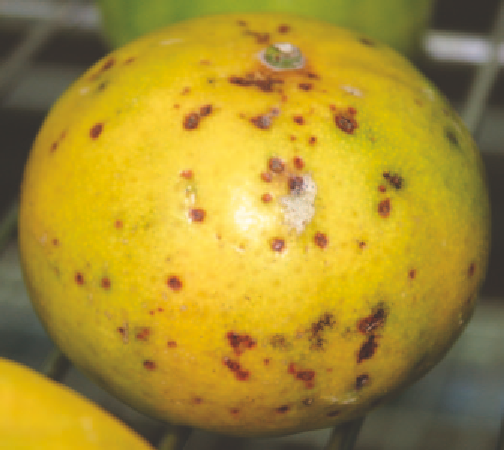Agriculture Reference
In-Depth Information
(e.g. bruised, injured), over-mature or stressed (e.g.
degreened at high ethylene concentrations), or chilling
injury. Spores of
C. gloeosporioides
are abundant on dead
citrus twigs and are spread by rain or overhead irrigation.
covering up to half the fruit surface. This occurs more
commonly after harvest, or in Valencia oranges held late
on trees. Large numbers of small fruiting bodies give
these areas a darkly speckled appearance.
Occasionally small, slightly sunken spots up to 3 mm in
diameter are expressed on mature, senescing or stressed
leaves in which dark, pycnidial, vegetative fruiting bodies
may develop.
Importance
Anthracnose is usually only a problem in fruit with a
predisposing condition (e.g. chilling injury, ethylene burn).
Management
•
Harvest fruit early if premature senescence of the rind is
occurring.
Handle fruit carefully during and after harvest to
minimise injury.
•
Store fruit at the optimum temperature.
•
Apply recommended registered pre- and postharvest
fungicide treatments.
•
BLACK SPOT
■
Cause
The fungus
Guignardia citricarpa
(anamorph
Phyllosticta
citricarpa
).
Symptoms
Fruit symptoms can be classified into four distinct types:
Fig 6.18 Speckled blotch symptoms of black spot. Note the stippling
around the spots.
(
a
)
Speckled blotch, which occurs as numerous minute,
dark brown stipplings within localised, circular areas
up to 6 mm in diameter; this is the characteristic
speckling of the skin. Speckled blotch develops on
maturing fruit (e.g. early Navel oranges) when late
summer and early autumn weather is abnormally hot
and dry.
(
b
)
Freckle spot, which develops as deep-orange to brick-
red, slightly depressed spots up to 1 mm wide on
collapsed oil glands. These enlarge to produce the
hard spot or virulent spot symptoms described below.
(
c
)
Hard spot, which appears as circular, depressed spots up
to 3 mm wide, and has grey to white centres and black
margins. A ring of dark green tissue may surround the
spot when the fruit is mature. The spots contain small,
black, fruiting bodies (pycnidia) of the fungus.
(d) Virulent spot, which occurs on colouring fruit when
numerous infections express simultaneously, expand
rapidly under warm conditions and coalesce, sometimes
Fig 6.19 Freckle spot symptoms of black spot. Slightly depressed
spots up to 1 mm wide enlarge to become a hard spot.













